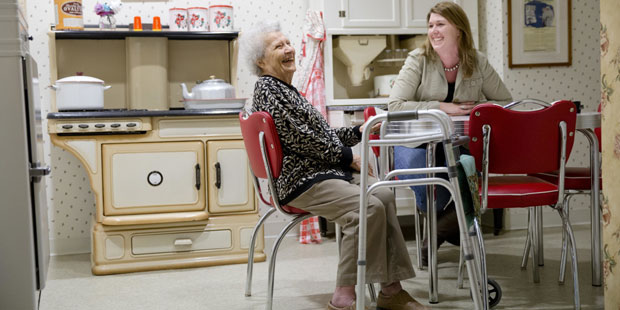Arizona researchers using Colombian village to research Alzheimer’s disease
Mar 15, 2017, 4:38 AM | Updated: Mar 16, 2017, 9:33 am

(Pexels Photo)
(Pexels Photo)
This is the third of a five-part, weeklong series studying how Alzheimer’s disease can affect you, no matter your age. Read the other parts here.
PHOENIX — When a patient hears he or she has cancer or heart disease, there is often a glimmer of hope there might be a cure or a way to manage the diagnosis.
But, when that diagnosis is Alzheimer’s disease, the window of hope shuts tight. At least, until very recently.
When doctors diagnosed 86-year-old Richard Yavitt with mid- to late-stage Alzheimer’s, he was already 10 years on the decline and fit the scientific profile that one in three Americans over 80 would develop dementia.
His wife, Barbara, said he sleeps most of the day, and when he is awake, “he doesn’t always know who I am.”
Richard is fiddling with a large Rubik’s Cube.
“He likes the primary colors,” she said.
The former certified public accountant isn’t interested in solving the puzzle, but doctors working under one large umbrella here in Arizona are interested in solving his disease.
Specialists Dr. Edward Zamrini and Dr. Pierre Tariot at Banner Alzheimer’s Institute are just two of the hundreds of minds working collaboratively under the Arizona Alzheimer’s Consortium, a collaborative group of scientists from multiple arenas researching and treating dementia.
The two men are working on sister projects trying to get ahead of the disease with a specific premise.
“We had this idea that prevention research could be done,” said Tariot, who admits the idea was considered a little out there by industry standards. “Not many people believed in it, which is always a mark of a good idea.”
They remained optimistic, even though finding people who fit the prerequisite for participation in the study was less than 3 percent of the population.
First, they needed to identify people who definitely carried the Alzheimer’s gene, would live long enough to complete the study and, ideally, find them before they were ever diagnosed.
“We were struggling to identify people who were known to be at very elevated risk,” Tariot admitted. “We didn’t think we could find enough people.”
At the same time, 1,400 miles south of Phoenix, another team of scientists was discovering a very rare form of Alzheimer’s concentrated in a village near Medellin, Colombia.
A mutual friend and scientist connected Tariot with Dr. Francisco Lopera, who had found, “an extraordinarily large concentration of families that carry a genetic code that cause them with certainty to die in their 30s, 40s and 50s.”
What’s worse, he continued, “it will happen to half of their children.”
The discovery prompted Lopera and his team to scour centuries of Medellin church and hospital records.
“All of these families (traced) back to a single Spanish immigrant in the 1600s,” he said.
Because it was Medellin — a beautiful mountain village, isolated from most of the world — Tariot realized the families rarely migrated. From a scientist’s perspective, this tragic thread of life had a beautiful purpose.
“You’ve got this accidental laboratory for this very rare form of early on-set Alzheimer’s.”
His team met with the Colombian researchers and about 30 families agreed to participate.
Like any experiment, “It might or might not work,” he explained, and “they started nodding their heads and said, ‘We’re in!’”
“I still get goosebumps when I think about the first interactions with these families. It was humbling and inspiring how willing they were to listen, how thoughtful.”
Having found a 400-year-old single genetic mutation in the middle of the Colombian mountains was the proverbial needle in the haystack they needed to convince scientific, governmental and pharmaceutical leaders to take a chance and invest in their preventative Alzheimer’s theory.
“Let’s take people who have no trouble with memory and thinking, but are destine to develop symptoms of Alzheimer’s pretty soon,” Tariot proposed. “Let’s give them a promising experimental therapy and let’s see if we can stave off the inevitable loss of memory.”
The stakeholders agreed and set up a funding source to put Alzheimer’s research teams around the globe on the fast track.
The general consensus was, “Go big, or go home,” Tariot remembered vividly. The team set up the study’s infrastructure on a global scale.
With the U.S. government’s green light, a pharmaceutical giant’s support, and funding from global stakeholders, they set to work.
Under Tariot’s supervision, the Arizona team, “secured FDA-like approvals in multiple countries, helped set up technology, trained the Colombian research team on how to conduct the study, and supported them every step of the way.”
“We can now harvest the data and analyze it … and we’ve committed to make it available to the entire scientific community a year from now.”
This month, the enrollment phase was completed and the data collecting is now underway.
And, because the program has U.S. and global government funding, that data will not be withheld for commercial profit.
“We have an agreement with our industry partner that the data and the samples collected during this study will be shared with the entire scientific community.”
The clock is ticking and, in March 2018, that data will be released for the best and brightest minds around the world to work under an even greater umbrella and hopefully find a cure or a path to finally solving the Alzheimer’s puzzle.
“This is good,” laughed Richard, still holding his Rubik’s Cube, while reaching for another puzzle, “How about more stuff?”
Although the study may not help him in his late stages of Alzheimer’s disease, Zamrini believes it could help the next generations that follow.
“Even if we delay [Alzheimer’s disease] by about five years, it would make a significant impact because we would probably eliminate half the cases,” he imagined. “If we delay it by about 10 years, we would eliminate 70 percent or more.”
To learn more about Alzheimer’s disease and research being done here and around the world, visit the following resources:
Arizona Alzheimer’s Consortium
The Banner Alzheimer’s Institute
Translational Genomics Research Institute
University of Arizona Health Sciences Alzheimer’s Research
Arizona State University Bio Design Institute








